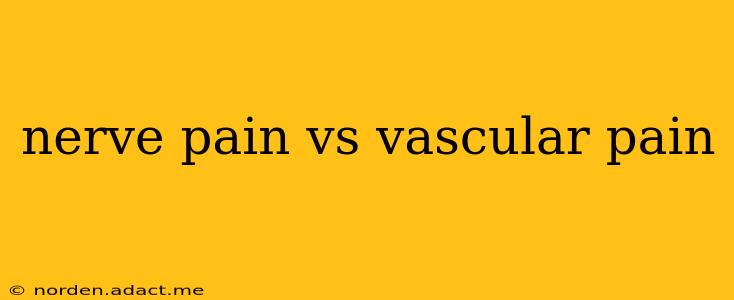Differentiating between nerve pain (neuropathic pain) and vascular pain can be challenging, as both can present with similar symptoms like aching, throbbing, and burning sensations. However, understanding their underlying causes, locations, and characteristics allows for more accurate diagnosis and treatment. This article delves into the key differences between nerve pain and vascular pain, addressing common questions to provide a comprehensive understanding.
What is Nerve Pain (Neuropathic Pain)?
Nerve pain, also known as neuropathic pain, arises from damage or dysfunction within the nervous system itself. This damage can occur in the peripheral nerves (those outside the brain and spinal cord) or the central nervous system (brain and spinal cord). The pain signals are often distorted or amplified, leading to chronic and sometimes debilitating pain. Neuropathic pain can manifest in various ways, including:
- Burning: A searing, hot sensation.
- Shooting: Sharp, stabbing pains that radiate along the nerve pathway.
- Tingling: A pins-and-needles sensation.
- Numbness: A loss of sensation.
- Hypersensitivity: Increased sensitivity to touch, temperature, or pressure (allodynia).
Several factors can contribute to nerve pain, including diabetes, shingles, multiple sclerosis, chemotherapy, nerve injury (trauma), and certain autoimmune diseases.
What is Vascular Pain?
Vascular pain stems from problems with blood vessels, such as arteries, veins, or capillaries. It's caused by reduced blood flow, inflammation, or pressure changes within the vascular system. The pain is often described as:
- Aching: A dull, persistent pain.
- Throbbing: A pulsating pain that synchronizes with the heartbeat.
- Cramping: A tight, squeezing sensation.
Vascular pain can be caused by conditions like:
- Peripheral artery disease (PAD): Reduced blood flow to the limbs, typically causing pain in the legs and feet during exertion.
- Deep vein thrombosis (DVT): A blood clot in a deep vein, often causing leg pain, swelling, and warmth.
- Raynaud's phenomenon: Vasospasm (narrowing of blood vessels) in the fingers and toes, causing pain, numbness, and color changes.
- Migraine: While primarily a neurological condition, vascular factors are involved in the development of migraine headaches.
How Can I Tell the Difference Between Nerve and Vascular Pain?
Differentiating between nerve and vascular pain requires a thorough medical evaluation. However, some clues can help distinguish them:
- Location: Nerve pain often follows a specific nerve pathway (dermatome), while vascular pain is usually localized to the affected blood vessel.
- Character: Nerve pain tends to be described as burning, shooting, or tingling, while vascular pain is often aching, throbbing, or cramping.
- Aggravating factors: Nerve pain might worsen with light touch or temperature changes, whereas vascular pain might be aggravated by exertion or changes in posture.
- Associated symptoms: Nerve pain may be accompanied by numbness, tingling, or weakness, while vascular pain might be associated with swelling, redness, or changes in skin color.
What are the Common Treatments for Nerve Pain?
Treatment for nerve pain focuses on managing the symptoms and addressing the underlying cause. This may include:
- Medications: Analgesics (pain relievers), antidepressants, anticonvulsants, and topical creams.
- Physical therapy: Exercises to improve range of motion and reduce pain.
- Alternative therapies: Acupuncture, massage, and yoga.
- Nerve blocks: Injections to numb the affected nerve.
What are the Common Treatments for Vascular Pain?
Treatment for vascular pain depends on the underlying cause and may include:
- Medications: Anticoagulants (blood thinners) for DVT, vasodilators to improve blood flow.
- Lifestyle changes: Exercise, diet modification, smoking cessation.
- Surgical interventions: Angioplasty or bypass surgery for PAD.
Can Nerve and Vascular Pain Occur Together?
Yes, it's possible to experience both nerve and vascular pain simultaneously, particularly in conditions affecting both the nervous and vascular systems, like diabetes. Proper diagnosis is essential to develop an effective treatment plan addressing both types of pain.
How is Nerve Pain Diagnosed?
Diagnosis of nerve pain often involves a physical exam, neurological exam, and sometimes imaging studies (like MRI or electromyography/nerve conduction studies) to identify the location and extent of nerve damage.
How is Vascular Pain Diagnosed?
Diagnosis of vascular pain might involve a physical exam, Doppler ultrasound, angiography, or other imaging techniques to assess blood flow and identify any blockages or abnormalities in blood vessels.
Disclaimer: This information is for educational purposes only and should not be considered medical advice. Always consult with a healthcare professional for diagnosis and treatment of any pain condition. They can accurately assess your specific situation and recommend the best course of action.
